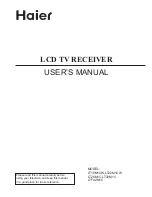
43
Glossary
Active Control
A set of automatic picture improvement
algorithms applied to the video image.
Aspect Ratio
The proportions of a rectangular display
screen. NTSC television has a 4:3 ratio;
HDTV is 16:9.
Audio/Video Inputs
Located on the rear of the TV these
connectors (RCA phono type plug) are
used for the input of audio and video
signals. Designed for use with VCRs (or
other accessories) in order to receive
higher picture resolution and offer sound
connection options.
Audio Output
An adjustable audio output which allows
for volume variations at the source.
Auto Picture and Sound Controls
Buttons on the remote control to select
predefined picture and sound settings.
Coaxial Cable
A single solid antenna wire normally
matched with a metal plug (F-type) end
connector that screws (or pushes) directly
onto a 75 Ohm input found on the
Television or VCR.
CVBS
Stands for Composite Video Blanking Sync.
At this level, the color, luminance and
synchronization information are combined
in one signal.The audio signal is
transferred separately.
Display
An on screen message or graphics that
help the user operate and adjust TV
feature controls. See On Screen Displays
(OSD).
LED
Light Emitting Diode or indicator.
Menu
An on-screen listing of feature controls
shown on the TV screen that are made
available for user adjustments.
MPAA
Motion Picture Association of America
Multichannel Television sound (MTS)
The broadcast standard that allows for
stereo sound to be transmitted with the
TV picture.
Natural Motion
Philips Technology that makes movement
on television less jerky and appear more
natural.
NTSC
(analog video signals)
National Television Standards Committee
format devised for TV broadcasting signals
in the 1940s (525 lines: 60 Hz.)
On Screen Displays (OSD)
Refers to the wording or messages
generated by the TV to help the user with
specific feature controls (color
adjustment, programming, etc.)
Picture Freeze
TV mode which allows you to “freeze” a
certain image in order to study a specific
detail at ease, e.g. to make notes of certain
program information like phone numbers.
Programming
The procedure of adding or deleting
channel numbers into the TV’s memory
circuits. In this way the TV ‘remembers’
only the locally available or desired
channel numbers and skips over any
unwanted channel numbers.
RF
Radio Frequency or modulated signal
design used as the carrier for television
broadcasts.
Second Audio Program (SAP)
Another or additional audio channel
provided for in the Multichannel Television
Sound (MTS) broadcast standard. A
monaural soundtrack included within the
recorded or video signal (usually
containing a second language translation
for the displayed programming).
Sleep Timer
Function with which you can set a time
period after which the TV should switch
itself to standby.
Subwoofer
A speaker designed for audio playback of
only the lowest-frequency notes (under
100 Hz).
Surround Pro Logic
Literally wraps you in 4-channel sound. It
brings your favorite movies to life with all
the realism and impact of cinema sound as
though you are part of the action.
S-Video Input
Allows direct connection of high-
resolution video sources, such as a Super
VHS videocassette recorder, Laser Disc
player, etc. Provides improved picture
resolution, sharpness, and clarity.
Tint
TV-function to modify the general color
balance between cool and warm and to
adjust it according to your personal
preference.
Glossary
2080.2 am 28-05-2001 10:31 Pagina 43




































